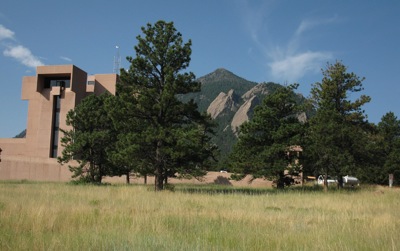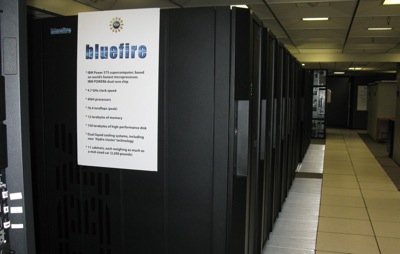I’m spending the week in Boulder, CO, attending a series of lectures and discussions at the National Center for Atmospheric Research (NCAR). The center is a hub for climate modeling using some of the world’s most advanced computers–but scientists here are working on a dizzying array of projects, from “wind prospecting” models for siting utility-scale wind farms in Colorado, to tracking the ozone drift from California wildfires, to studying the relationship between weather and meningitis in Sub-Saharan Africa.

While NCAR works closely with NOAA (which also has a major research center in town), it is not part of it. NCAR is funded by the National Science Foundation and managed by something called the University Corporation for Atmospheric Research (UCAR), a consortium of about 75 North American universities, as well as major institutions abroad.
About 400 scientists work under the NCAR umbrella, including Kevin Trenberth, a leading authority on the link between El Nino and global climate. Right before hopping a plane for Australia this week, Trenberth, head of NCAR’s Climate Analysis Section, reaffirmed what NOAA and others have been saying; that we may be in for a significant El Nino event this fall and winter.
“There are good signs below the surface of the ocean in the tropical Pacific that this is the real deal,” said Trenberth. He echoed some of the optimism expressed by many Californians that the result could be an overdue dousing after three years of accumulating drought conditions. “The odds are, if it’s a good El Nino,” said Trenberth, “that there is more likelihood of a southerly storm track that’ll bring a lot of weather systems into southern California in particular. It’s not always clear what happens in northern California but the odds are that there’s a much more active southern storm track right across the U.S. and in particular in California.”

NCAR scientists continue to refine their climate models, which have been downloaded by more than 10,000 scientists around the world. UCAR invests $20-to-$30 million every four years in it’s Computational & Information Systems Lab (CISL), to maintain it’s state-of-the-art status. CISL chief Rich Loft says it’s probably the most advanced supercomputing center devoted largely to climate analysis.
Even so, NCAR is busy building a bigger, faster one–but not here. The new supercomputer, which may be ready by 2012, will be sited near Cheyenne, Wyoming, mostly to take advantage of the cheap, abundant electric power in that area. Loft and NCAR Director Eric Barron both concede the paradox that the most advanced computer assault on global warming is itself a huge gobbler of electricity, much of which comes from coal-fired power plants. The Wyoming facility will suck down 4.5 megawatts of power. Barron says at least there’s a major wind farm “right next door.”
The center’s carbon footprint is probably also swollen slightly by its own air force. NCAR operates two aircraft packed with advanced instrumentation; a hulking C-130 Hercules and a sleek, high-altitude Gulfstream V. Sadly, no rides were offered this week.
6 thoughts on “A Climate Reporter’s Candy Store”
Comments are closed.

Craig, a request (or, if this doesn’t sound like a good idea, could you explain why not) –
Anytime you, or any journalists, dip into “look at the carbon footprint of this effort to reduce our carbon footprints” territory, could you explain the concept of investment? i.e., that in order to save a lot, you often need to spend a little? I think most of us understand it, but the ones we most need to reach might not.
Not explaining it is like saying “it was cold in Walla Walla yesterday” in the context of a climate story while failing to note the distinction between weather and climate – it gives your readers an opportunity to stay misinformed. I don’t think we can afford that.
Also, how about a review of Greg Craven’s new book for laypeople, “What’s the Worst that could happen?” – I’d be interested in hearing what you think of it, and whether you’d recommend it.
(I’m low on disposable income these days, but after buying and reading it, I’ve ordered 10 more)
As you must know, Anna, that “territory” isn’t my normal stomping grounds. I tend to view that type of coverage as petty and steer clear of it. I hope my comments above were understood to be affable needling, not a serious critique of the computing plan. In fact, the NCAR director brought it up himself.
As for the book, it hasn’t crossed my desk yet but we often invite authors of new books on climate change to submit guest posts to the blog.
Sorry Craig. Emotions don’t come through well in this medium.
> As for the book, it hasn’t crossed my desk yet
Bet you a dollar that if you buy and read it, you’ll be very glad you did.
Craig,
Bet you a dollar that if you email with with an address, I’ll send you a copy for free. Publicity is almost nil. Everyone who’s read it (save one reviewer on Amazon) and gotten back to me says it’s worthwhile, but bottom line is: no one knows it exists.
Cheers,
Greg Craven
KQED Climate Watch
2601 Mariposa St.
San Francisco, CA 94110
Craig,
I’ve sent a message to Penguin to send you a review copy. They won’t be back in the office until Tuesday. If you don’t get it within a week of that, please email me directly at wonderingmind42 at gmail dot com.
Greg